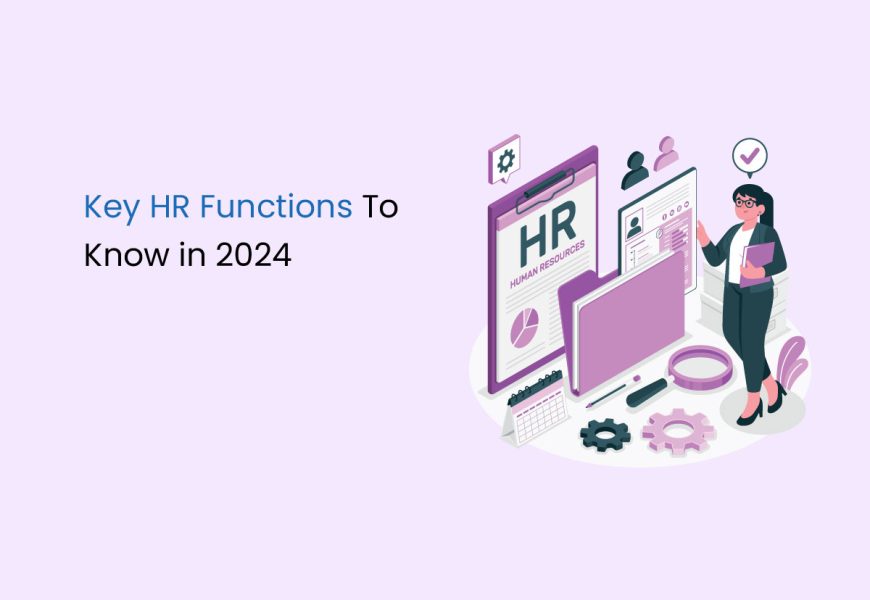There are a lot of misconceptions about what Human Resources professionals do. Some people believe that HRs simply interview candidates and sometimes hold diversity training. However, this obviously cannot be farther from the truth.
This field has grown immensely as the needs of a company also grown in multifaceted ways. However, the overarching aim is still the same: to build a positive work environment that allows employees to have a meaningful tenure at the company. This article intends to take a deeper dive into the primary and upcoming trends in HR functions in the year 2024.
What is an HR Function List?
Simply put, an HR functions list serves as a crucial guide that outlines the core responsibilities of HR professionals, helping to define their role within an organisation. It summarises their key priorities and clarifies the overarching mission of the HR department.
At its core, an HR functions list:
- Clearly defines HR’s role in fostering a positive and productive workplace environment.
- Encourages collaboration and alignment among HR professionals, ensuring they work together effectively.
- Aligns HR objectives with the broader mission and goals of the company, helping to drive overall organisational success.
This list acts as a roadmap, ensuring that HR initiatives support the company’s vision while also promoting a harmonious workplace.
Why is an HR Functions List Important?
An HR functions list is essential for consolidating the diverse and dynamic roles that HR professionals undertake, especially in a fast-evolving environment shaped by technological advancements.
An HR functions list can:
- Enhance productivity and overall performance by providing clarity on key responsibilities.
- Foster stronger internal collaboration and teamwork within the HR department.
- Serve as a guide for HR professionals, ensuring their efforts are aligned with the company’s broader goals.
What All Does HR Do?
An HRs role is dependent on the size of the company they work at. As per the size, the roles and responsibilities can be bifurcated and divided. Let’s look at them briefly below.
Talent Acquisition and Retention
Recruiting, hiring, and retaining talent are some of the most vital functions within any HR department, yet their significance often goes beyond simple staffing. Ensuring that a company’s workforce aligns with its broader goals is key to maintaining its overall health. HR professionals are at the forefront of this effort, continually assessing personnel levels to meet organisational demands. They also play a pivotal role in strategic decision-making when it comes to expanding teams, restructuring departments, or making tough calls about staffing.
When it comes to recruiting, the process begins with crafting precise job descriptions and setting competitive salary ranges based on market analysis. From there, HR promotes the positions across various platforms and screens applications to identify candidates who are the best fit. These selected candidates move through multiple rounds of interviews with employees, managers, and senior leadership before final decisions are made.
The hiring process, however, goes far beyond just selecting a candidate. HR is responsible for conducting background checks, onboarding new hires, and explaining crucial details such as payroll, benefits, and company policies. Legal compliance and meticulous recordkeeping are essential to ensure the security of both employees and the company.
Equally important, yet often overlooked, is HR’s role in employee retention. While hiring is important, it is important to have a valid strategy to retain employees. As per multiple statistics, hiring is way costlier than retention for the company in terms of manhours as well as resources spent. This is why HR works to ensure employees stay engaged and satisfied in their roles. According to research from the Society for Human Resource Management (SHRM), the top factors contributing to job satisfaction include respectful treatment, trust in senior management, opportunities to use skills, fair compensation, and job security. These elements are at the heart of retaining a motivated workforce.
Employee Engagement
Employee engagement is often misunderstood, but it plays a fundamental role in creating a cohesive and thriving work environment. The relationship between employees and HR, as well as senior leadership, is key to fostering a strong company culture where everyone rallies around shared goals and values. Without open, two-way communication, issues can go unnoticed, eventually leading to bigger problems that could have been resolved early on.
To create a supportive atmosphere, HR can implement several initiatives designed to strengthen trust and rapport between leadership and employees. These efforts include recognising individual and team accomplishments, sharing both successes and setbacks openly, and actively seeking feedback to address concerns. Organising company-wide gatherings, clearly communicating policies and strategic decisions, and stepping in to mediate conflicts are all vital components of building a more engaged workforce.
Administration
The administrative responsibilities of HR are fundamental to its overall function within any organisation. These responsibilities cover personnel procedures and the management of the Human Resource Information System (HRIS), both of which ensure the smooth operation of employee-related processes.
Personnel procedures involve managing a range of situations, including promotions, relocations, disciplinary actions, performance improvements, illness, regulations, and issues related to diversity, harassment, and bullying. For each of these matters, HR must establish and adhere to clear policies and procedures that address employee requests, concerns, and complaints, ensuring they are handled effectively.
Human Resource Information System (HRIS) plays a crucial role in managing employee data. HR is tasked with selecting, implementing, and overseeing these systems, which provide valuable insights for better decision-making and improved operational efficiency.
A recent example of more effective HR processes can be seen with GLS, a national logistics leader in the USA. GLS streamlined its HR and payroll systems across the U.S. by implementing Paylocity, an advanced HR software. Replacing multiple outdated systems helped GLS improve its ability to swiftly recruit, onboard, and train employees—critical in an industry facing over 90% turnover.
Performance Management
Performance management is a critical aspect of any HR function, focused on maintaining or enhancing job performance through a variety of methods. This often includes using assessment tools, coaching, and offering ongoing feedback to employees. How a company approaches performance management can vary greatly depending on its size and structure. A large corporation with a dispersed workforce might rely on specialised software to track and manage remote teams, while a smaller organisation with fewer employees working in a single location may take a more hands-on approach.
Compensation
Compensation and benefits also play a pivotal role in HR’s responsibility to attract and retain talent. Fair compensation, combined with a comprehensive benefits package, is what employees receive in exchange for their contributions to the company. Crafting competitive offers that align with both industry standards and employee expectations is essential. Compensation typically includes a salary or hourly wage, while benefits can range from health insurance and retirement plans to paid time off, sign-on bonuses, and even stock options.
The goal is to ensure that employees feel valued and fairly rewarded, which contributes to a more motivated and engaged workforce.
Training And Development
Development and training are crucial elements of any successful organisation, yet their significance often goes beyond simple skill-building. Offering employees opportunities to grow not only enhances their productivity and performance but also strengthens the company as a whole. By investing in robust professional development programs, companies can promote from within, reduce turnover, and foster a culture of continuous improvement. When employees feel supported in their growth, they are more likely to engage positively with the company’s culture and contribute to its evolution.
HR also plays a key role in providing training that aligns with both the company’s strategic goals and legal obligations. These training sessions often cover important topics like diversity and inclusion, recognising and reporting harassment, and staying up to date with industry trends and emerging technologies. Such initiatives ensure that employees are not only equipped with the skills they need to succeed but also understand their roles in maintaining a safe and equitable workplace.
Risk Management
This is a vital function within the roles of HR. While HR professionals may not handle risk management exclusively, they are integral to identifying and resolving risks that could impact the company or its employees. This might involve training managers, gathering anonymous employee feedback, ensuring diversity measures are upheld, and working with IT to protect sensitive data. HR also investigates complaints related to harassment or discrimination, helping to ensure that the work environment remains fair and secure for everyone.
Legal Compliance and Audits
Audits and legal compliance are essential yet often misunderstood aspects of HR’s responsibilities. Labour laws, benefits regulations, and compensation guidelines can be complex, varying by state and frequently changing. Any organization must stay informed about and adhere to these laws at the federal, state, and local levels to avoid costly legal pitfalls.
According to the Society for Human Resource Management (SHRM), many legal issues in companies arise from areas such as hiring, performance management, employee discipline, and termination. High-risk areas also include outdated labour law posters, poorly protected personnel records, inadequate record retention, and inaccurate timekeeping or wage records.
To avoid any missteps, a proactive HR department conducts regular compliance audits. These audits review internal policies and procedures to ensure they align with legal standards and best practices. By staying ahead of potential legal issues, HR ensures the company remains in compliance, safeguarding both the organisation and its employees.
Employee Wellbeing
Supporting employee wellbeing is a vital function of HR, aimed at ensuring staff can perform at their best. This involves actively promoting mental, physical, and financial wellbeing throughout the workforce.
HR professionals also play a key role in assisting employees when things go wrong, whether those issues stem from the workplace or external factors. Problems like these can negatively impact employee performance, engagement, and productivity, which in turn affects a company’s overall success. With 81% of employees at risk of burnout and 51% worried about their financial future, focusing on employee wellbeing is more crucial than ever for an organisation’s long-term success.
A holistic well-being strategy, led by HR should operate both at the individual level and across teams and departments. For instance, a company might offer an employee assistance programme, providing counselling services for those dealing with mental health challenges. On a larger scale, the organisation could host initiatives such as a mental health awareness day to foster a supportive work environment.
An example of an effective wellbeing strategy can be seen with Three UK, a British telecommunications provider. In response to the challenges posed by the introduction of 5G, the company implemented a series of wellbeing initiatives. These included free flu vaccinations, a meeting-free period on Wednesdays, and three paid personal days each year.
This strategy proved highly successful, with 83% of office employees reporting satisfaction in exit surveys. Additionally, the company’s employee Net Promoter Score (eNPS) rose from +16 to +24, and the flu vaccination programme led to a 25% reduction in sickness rates. Such initiatives demonstrate the tangible benefits of prioritising employee wellbeing.
HR Department’s Structure and Functions
The relationship between an HR department’s structure and its functions is vital to how efficiently it operates. While an HR functions list outlines the core responsibilities of HR professionals, the structure of the department provides the framework within which those responsibilities are carried out. The structure determines whether decision-making is centralised or decentralised and helps leadership identify potential gaps in the organisation’s operations.
HR departments may adopt various structural models:
- Hierarchical structure: A traditional vertical model based on seniority, where communication flows from the top down. This is commonly used in larger organisations with clearly defined roles.
- Goal-oriented structure: In this model, leadership assigns goals to individual teams, who then have the autonomy to regulate their strategies and measures. It offers flexibility and empowers teams to take ownership of their objectives.
- Shamrock model: This structure focuses on delegating tasks to the most qualified and knowledgeable team members. It is particularly suited for smaller organisations where flexibility and efficiency are key.
- Networking and outsourcing model: Here, HR departments seek support from external sources, such as consultants, to fulfil their functions. This model is ideal for organisations with a small in-house HR team, allowing them to tap into specialised expertise when needed.
Each structure influences how HR professionals collaborate, communicate, and achieve the organisation’s goals, choosing model critical to the department’s effectiveness.
Upcoming Trends in HR Functions
In recent years, businesses have faced unprecedented challenges, from the COVID-19 pandemic to global inflation and a growing skills shortage. These pressures have pushed the workplace into uncharted territory, prompting significant shifts in human resource management. One of the most notable developments has been the need to manage the widespread adoption of remote and hybrid working models, which has become a critical HR function.
Other recent trends and developments in HR functions include:
- Change management: In the wake of the pandemic, the importance of change management has gained considerable traction in business discussions. This proactive and systematic approach helps organisations navigate changes in goals, processes, or technologies, ensuring smooth transitions and minimising disruptions.
- Human leadership: The post-pandemic landscape has been dubbed the “era of human leadership” by many HR professionals. Data-driven HR analytics revealed declines in employee engagement alongside increases in burnout and turnover. In response, there is a growing emphasis on empathetic, transparent, and adaptive leadership that prioritises teamwork, collaboration, and the well-being of employees.
- The metaverse: Although still in its early stages, the metaverse has the potential to reshape the workplace by offering a fully immersive virtual reality environment. As this technology develops, employees will be able to collaborate as digital avatars, helping to bridge the gap between remote workers and combat the isolation often experienced in virtual settings.
These trends highlight the evolving nature of HR, as it adapts to the demands of a rapidly changing work environment while keeping people at the forefront of its strategy.
In Conclusion
HR is a dynamic, multi-faceted role that empowers companies to maximise the potential of their workforce. As an HR professional, you must possess a broad skill set to effectively manage key HR functions. However, education and training don’t end with earning your initial qualification. With society and the workplace constantly evolving, continuous professional development is essential to confidently navigate and lead through change.
TankhaPay can help businesses achieve these HR functions with greater proficiency. Payroll and HR process automation is the way of the future, and TankhaPay is leading the way. We reduce the administrative burden, allowing HR teams to focus on strategic initiatives such as employee engagement, talent acquisition, and well-being.
The platform also streamlines compliance, ensuring companies remain aligned with ever-changing regulations, thus improving overall efficiency. Contact us today for your HR needs.
FAQs on HR Functions
What are the 7 functions of HR?
The HR department performs several essential functions to ensure the smooth operation of a business. These include:
- Recruitment and Hiring: HR oversees the entire hiring process, from sourcing candidates to selecting the best fit for the role.
- Training and Development: HR ensures that employees receive appropriate training to grow in their roles and advance professionally.
- Employer-Employee Relations: HR manages the relationship between the company and its employees to maintain a positive work environment.
- Maintaining Company Culture: HR promotes a cohesive culture that reflects the organisation's values and goals.
- Managing Employee Benefits: HR is responsible for designing and administering employee benefits packages.
- Creating a Safe Work Environment: HR ensures that the workplace meets health and safety regulations.
- Handling Disciplinary Actions: HR handles issues related to employee behaviour and performance, implementing disciplinary actions when necessary.
What are the 7 pillars of HR?
HR’s functions are built upon seven key pillars:
- Talent Management, Recruitment, and Selection
- Learning and Development
- HR Performance Management
- Compensation and Benefits
- Employee Relations
- Legal and Regulatory Compliance
- HR Technology and Analytics
What is the role of HR?
The HR department plays a pivotal role in managing the employee lifecycle, which includes recruiting, hiring, onboarding, training, and handling employee exits. Additionally, HR is responsible for administering benefits, fostering employee relations, and ensuring compliance with labour laws. HR helps maintain a productive, safe, and engaging workplace environment for all employees.





















